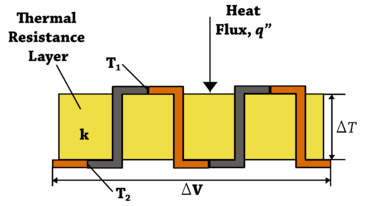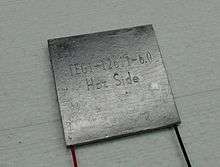Thermopile


A thermopile is an electronic device that converts thermal energy into electrical energy. It is composed of several thermocouples connected usually in series or, less commonly, in parallel.
Thermocouples operate by measuring the temperature differential from their junction point to the point in which the thermocouple output voltage is measured. Thermocouples can be connected in series as thermocouple pairs with a junction located on either side of a thermal resistance layer. The output from the thermocouple pair will be a voltage that is directly proportional to the temperature difference across the thermal resistance layer and also to the heat flux through the thermal resistance layer. Adding more thermocouple pairs in series increases the magnitude of the voltage output. Thermopiles can be constructed with a single thermocouple pair, composed of two thermocouple junctions, or multiple thermocouple pairs.
Thermopiles do not respond to absolute temperature, but generate an output voltage proportional to a local temperature difference or temperature gradient.
Thermopiles are used to provide an output in response to temperature as part of a temperature measuring device, such as the infrared thermometers widely used by medical professionals to measure body temperature, or in thermal accelerometers to measure the temperature profile inside the sealed cavity of the sensor[1]. They are also used widely in heat flux sensors and pyrheliometers[2][3] and gas burner safety controls. The output of a thermopile is usually in the range of tens or hundreds of millivolts.[4] As well as increasing the signal level, the device may be used to provide spatial temperature averaging.[5]

| Thermoelectric effect |
|---|
 |
|
Principles
|
Thermopiles are also used to generate electrical energy from, for instance, heat from electrical components, solar wind, radioactive materials, laser radiation or combustion. The process is also an example of the Peltier effect (electric current transferring heat energy) as the process transfers heat from the hot to the cold junctions.
See also
- Seebeck effect, the physical effect responsible for the generation of voltage in a thermopile
- Thermoelectric materials, high-performance materials that can be used to construct a compact thermopile that delivers high power
References
- ↑ Mukherjee, Rahul; Basu, Joydeep; Mandal, Pradip; Guha, Prasanta Kumar. "A review of micromachined thermal accelerometers". Journal of Micromechanics and Microengineering. 27 (12). doi:10.1088/1361-6439/aa964d.
- ↑ "Glossary of Meteorological Terms (T) - NovaLynx Corporation". Retrieved 17 November 2016.
- ↑ "Glossary". Retrieved 17 November 2016.
- ↑ "Glossary". Archived from the original on 3 March 2016. Retrieved 17 November 2016.
- ↑ "Capgo - Sensor Glossary". Retrieved 17 November 2016.
External links
- The Museum of Retro Technology: Thermo-Electric Generators
- TPA81 Thermopile detector Array Technical Specification